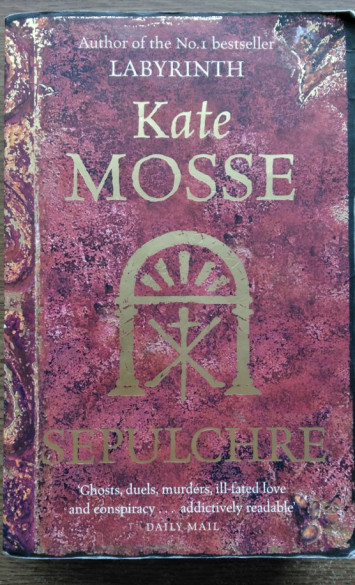 Title: Sepulchre
Title: Sepulchre
Author: Kate Mosse
Series: Languedoc Trilogy (2/3)
Time/Place: France 1891-7, 2007
Teaser: ‘This story begins with a pantomime of a burial.’
Summary: 1891: Leonie and Anatole Vernier leave Paris to live with their mysterious Aunt Isolde in the quiet Rennes-les-Baines. Anatole, fleeing an unknown fear, hopes the countryside will offer sanctuary, but Leonie is puzzled at her brother’s secrecy until she stumbles upon a secret in the woods. Meanwhile in 2007, Meredith Martin arrives at Rennes-les-Bains, desperate to trace her lost family history in the events of a hundred years before.
My Thoughts:
I picked this book up because I recognised its distinctive cover and connected it to another novel on my shelf, Labyrinth – although Labyrinth won’t have its own post as I read it too long ago, I decided that this was a series I’d finally start reading in the right order.
The history: This story is another set in a later period than I would usually choose, and I decided to read it chiefly because I was interested in the French location. The geography was one of the reasons that I originally chose Labyrinth, as Carcassonne is one of my favourite board games, and Mosse portrays the isolated French countryside in this book as well as she immersed the reader in the complexities of a city in its predecessor. In a story that connects two time periods chiefly through location, Mosse has a skilled way of tying history into place and landscape, especially in Aunt Isolde’s ancestral home. The uncertainty of a fin-de-siècle atmosphere comes together well with the themes of family mystery – these are especially strong in the opening scene, where Leonie attends an ill-fated opera with her brother. Overall, Mosse raises some interesting thoughts on how the past can affect the present, both supernaturally and in terms of lineage and local history.
The story: This book, like Labyrinth, a timeslip story that alternates between the past and present in solid chunks that eventually overlap and influence each other, creating a complex, double-threaded tale. Mosse’s style is intricate but fits well with her late-1800s era, and there is a good atmosphere of mystery and the uncanny, especially in the middle of the work. The fantasy lover in me was intrigued by the influence of fate and tarot across the two periods, and the historical facts surrounding the cards are well presented without feeling out of place. In general, the book runs slowly, with far less action than Labyrinth, but this is to be expected when dealing with a more modern time period. There is an increase of pace towards the end, which is tense and spooky, though a little confusing. Leonie is an appealing and sympathetic narrator, but I found Meredith, whose sections are smaller, less engaging – though I may be influenced by the fact that I read so little contemporary fiction these days that I’m just not used to following modern characters. Timeslip is a sub-genre of historical fiction that I’ve barely scratched the surface of, and should enjoy – like magical-realism or the gothic, it shares a borderline with fantasy whilst keeping the historical detail. In practice, I’m finding that it takes some getting used to, and I would like to read more by other authors and in different time periods before I make my mind up as to whether it’s for me.
My favourite character was Leonie – a fiery character with youthful flaws, but energetic and artistic, she was genuine and relatable 17-year-old girl who gains responsibility and poise over the course of the book.
Recommended: For those who enjoy a mystery, or have an interest in the Languedoc region. Anyone looking to get into timeslip stories would find this a good place to start.
My Rating: 3/5
Advertisements Share this:




